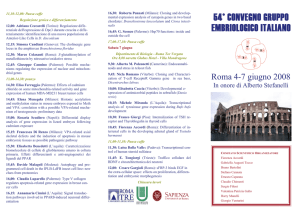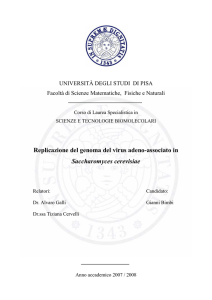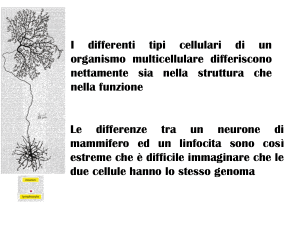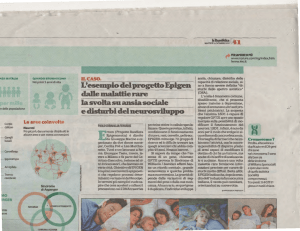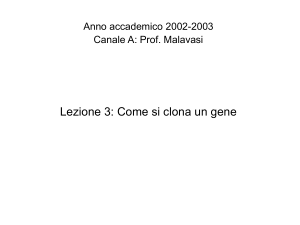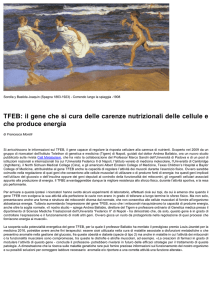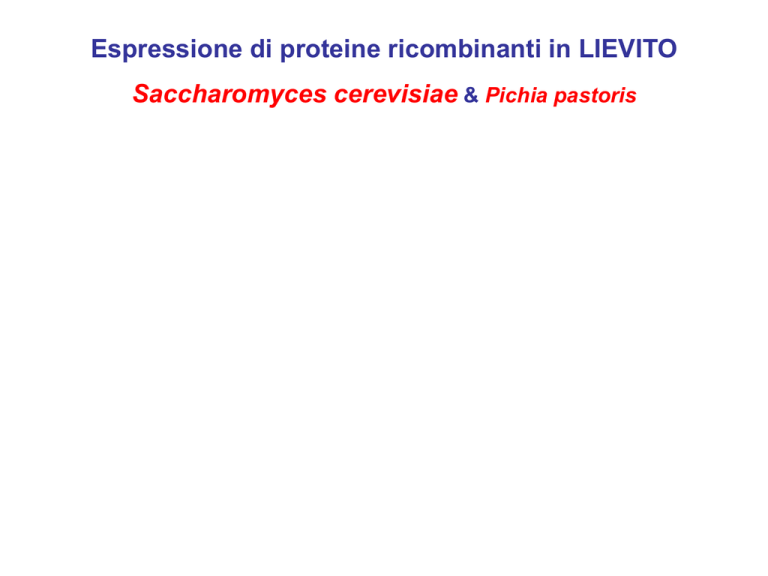
Espressione di proteine ricombinanti in LIEVITO
Saccharomyces cerevisiae & Pichia pastoris
Espressione di proteine ricombinanti in LIEVITO
Saccharomyces cerevisiae & Pichia pastoris
Vantaggi del sistema
ü Sono microorganismi eucariotici, evolutivamente più vicini ad organismi
complessi.
ü La loro coltivazione in laboratorio è semplice e relativamente economica
(assai simile a quella di cellule batteriche).
ü E’ possibile applicare svariate tecniche di ingegneria genetica,
sfruttando l’elevata capacità di ricombinazione omologa (gene
replacement).
ü Saccharomyces cerevisiae è un organismo modello, molto studiato in
termini genomici e proteomici, del quale si conoscono numerosi
meccanismi a livello molecolare.
Quali sono le caratteristiche di Saccharomyces cerevisiae?
•
Organismo GRAS (Generally Recognized As Safe)
•
Genetica e fisiologia estremamente ben conosciute
•
Cellule isolabili singolarmente e facilmente coltivabili
•
Ciclo cellulare sia aploide che diploide
•
Metabolismo sia aerobio che anaerobio
•
Isolati e sequenziati diversi promotori forti, nonché un plasmidio naturale (2 mm)
•
Cellule trasformabili
•
Secrezione di proteine minima
•
Strumento per l’analisi di geni eterologhi
•
Ridotta complessità genetica
→ Genoma completamente sequenziato
→ Progetto per l’attribuzione di una funzione alle orphan ORFs
1) preparazione protoplasti, via chimica o enzimatica
2) trattamento con LiAc
3) elettroporazione
cell
lag
log
st
La sua crescita ha un profilo tipico
t
Le condizioni nutrizionali influenzano la crescita del lievito (andamento della curva,
sporulazione)
I terreni di crescita possono essere solidi o liquidi e contengono sali minerali, vitamine, una
fonte di azoto e una di carbonio.
Si utilizzano terreni completi e terreni selettivi; esistono infatti numerosi marcatori nutrizionali
(e molti composti specifici) che permettono di selezionare i ceppi ingegnerizzati.
Inoltre, la fonte di carbonio utilizzata nella coltivazione del lievito determina l’attivazione di
percorsi metabolici specifici.
Esistono fonti di carbonio FERMENTABILI (Glucosio, Galattosio) e RESPIRABILI (Glicerolo,
Lattato, Etanolo).
COLTIVAZIONE DEL LIEVITO S. cerevisiae
Galattosio
Glucosio
Etanolo Glicerolo
Lattato
Glicolisi
Piruvato
FERMENTAZIONE
Etanolo
RESPIRAZIONE
Ciclo di Krebs
Bath & Murthy, Molecular Microbiology (2001), 40, p.1059
Nel 1948 (!) venne descritto per la prima volta un mutante incapace di fermentare il
galattosio alla stessa velocità del wild-type.
Long-Term Adaptation
GAL3 è espresso a livello basale in glicerolo, indotto 3-5 volte all’aggiunta di
galattosio, strettamente represso in presenza di glucosio.
Regolazione dipendente dalla fonte di carbonio
I geni GAL per il metabolismo del Galattosio sono organizzati in un
regolone e sono controllati a livello trascrizionale dalla fonte di carbonio
Gal3
Co-inducer/CYTOPLASM
repressor
DNA-binding transcriptional
activator
I geni GAL per il metabolismo del Galattosio subiscono una regolazione
trascrizionale duplice: repressione/derepressione e induzione
Glicerolo
Glucosio (± Gal)
Galattosio
Trascrizione geni GAL
L’aggiunta di galattosio fa aumentare di un fattore 1000 la trascrizione del
messaggero, fino a raggiungere l’1% degli mRNA totali → un potente e preciso
interruttore molecolare.
Elementi che hanno reso possibile l’ingegnerizzazione del lievito:
• isolamento di promotori regolabili (GAL1, PGK glucosio, CUP1 rame);
• isolamento di origini di replicazione → plasmide naturale 2µ, ARS;
• identificazione di markers di selezione → auxotrofie;
• possibilità di ottenere facilmente mutazioni condizionali
→ mutanti termosensibili “ts”;
• elevata frequenza di ricombinazione omologa.
Vettori utilizzabili in lievito
• plasmidi integrativi
YIp
• plasmidi replicativi
YEp
YRp
YCp
• cromosomi artificiali
YAC
… e ingegnerizzabili in E.coli, perché vettori navetta
Elementi che hanno reso possibile l’ingegnerizzazione del lievito:
• isolamento di promotori regolabili (GAL1, PGK glucosio, CUP1 rame);
• isolamento di origini di replicazione → plasmide naturale 2µ, ARS;
• identificazione di markers di selezione → auxotrofie;
• possibilità di ottenere facilmente mutazioni condizionali
→ mutanti termosensibili “ts”;
• elevata frequenza di ricombinazione omologa.
Marcatori di selezione:
come sono stati originariamente isolati?
Per complementazione in E.coli.
Transform Leu- E.coli
Plate onto medium lacking leucine
Marcatori di selezione usati più frequentemente
Elementi che hanno reso possibile l’ingegnerizzazione del lievito:
• isolamento di promotori regolabili (GAL1, PGK glucosio, CUP1 rame);
• isolamento di origini di replicazione → plasmide naturale 2µ, ARS;
• identificazione di markers di selezione → auxotrofie;
• possibilità di ottenere facilmente mutazioni condizionali
→ mutanti termosensibili “ts”;
• elevata frequenza di ricombinazione omologa.
“Gene targeting” mediante ricombinazione omologa
Knock-Out del gene URA3
Knock-Out del gene YFG
(knock-in del gene YFG)
(knock-in del gene URA3)
Left segment
of URA3
URA3::YFG
Right
segment of
URA3
Left
segment of
YFG
Right segment
of YFG
YFG::URA3
ESPRESSIONE DI PROTEINE RICOMBINANTI IN Saccharomyces
cerevisiae MEDIANTE SISTEMI GAL
Ponendo una sequenza
codificante sotto il controllo del
promotore GAL1, la sua
trascrizione viene fortemente
indotta in terreno contenente
Galattosio e può essere
immediatamente repressa in
presenza di Glucosio
Ciò permette un controllo
dell’espressione basato sulla
variazione delle condizioni di
crescita
Nel 1984 viene prodotto in lievito il primo vaccino ricombinante costituito da una subunità del capside del
virusdell’epatite B. I tentativi di produrlo in E. coli erano precedentemente falliti.
La proteina ricombinante è assai simile a quella naturale
e conserva anche la capacità di formare aggregati
immunogenici simili a quelli trovati in pazienti infetti.
…
…
Proteine ricombinanti
prodotte in S. cerevisiae
Problemi possibili per
l’espressione in questo sistema:
• perdita del plasmide
• iperglicosilazione di alcune
proteine (v. oltre)
• secrezione di proteine limitata
Improved production strains of yeast S.cerevisiae…
Altering the membrane lipid content …
Pichia pastoris
TASSO NO MIA: Euka ryota , Fung i, Asc o m yc ota , Sa c c ha rom yc o tina ,
Sa c c ha rom yc e te s,Sa c c ha ro m yc e ta le s, Sa c c ha rom yc e ta c e a e , Pic hia
Why is Pichia pastoris advantageous for industrial applications?
•
simplicity of the techniques
•
capacity to produce large (intra- or extra-cellular) quantities of protein
• possibility of post-translational modifications
• various commercialized systems
• easy to move from the lab- to the fermenter-scale
Expression of recombinant proteins in Pichia pastoris
P.pastoris is a yeast capable of expressing the recombinant protein at levels
10-100 times higher than in S. cerevisiae.
Its hyper-glycosilation activity is lower than that of S.cerevisiae and
thus its secretory properties are greater.
Some of the genetic engineering strategies used in S.cerevisiae are
similar to those employable with Pichia.
Sequencing of the genome completed and published, although relatively
late with respect to other species
(
).
Pichia pastoris is a methylotrophic yeast, capable of using methanol as the sole
carbon source.
Protein-coding genes were automatically
predicted using EuGene15... manually
curated for functional annotation,
accurate translational start-and-stop
assignment, and intron location.
This resulted in a 5,313 protein-coding
gene set of which 3,997 (75.2%) have at
least one homolog in the National Center
for Biotechnology Information protein
database.
The protein-coding genes occupy 80% of
the genome sequence.
To be used, the methanol must first be oxidized to formaldehyde in
peroxisomes by the enzyme alcohol oxidase.
METANOLO
O2
alcohol oxidase
FORMALDEIDE
H2O2
alcohol oxidase has low affinity for O2 and, when growing in methanol, the
yeast cell increases the production of the enzyme.
Pichia has two alcohol oxidase genes (AOX1, AOX2): AOX1 supports most
of the enzymatic cellular activity.
In Pichia pastoris, The gene AOX1 undergoes an adjiustement similar to that of
genes GAL in S.cerevisiae: repression / derepression and induction.
Glycerol
Glucose (± Methanol)
Methanolo
Transcription of gene AOX1
In methanol, the AOX1 protein represents about 30% of the soluble protein
and its mRNA 5% of the cell messengers.
The regulation of the AOX1 gene is therefore used for the production of
recombinant proteins in Pichia pastoris.
The loss of the gene AOX1 (MutS) confers to the cell a
distinctive phenotype, i.e. growth slowed in methanol.
Vectors
Promoters
– AOX1 (alcohol oxidase)
• Strong promoter
• Strongly inducible by methanol
• Repressed by D-glucose
– GAP (glyceraldehyde 3-phospate
dehydrogenase)
• Strong constitutive promoter
• High transcription in D-glucose,
• Moderate transcription in glycerol
• Low transcription in methanol
Markers
ARG4, URA3, HIS4, Sh ble (gene from Streptoalloteicus hindustanus)
Secretion signals
α-MF (S.cerevisiae mating factor a), PHO1 (P.pastoris acid phosphatase)
Expression of recombinant proteins in Pichia pastoris
1) Choice of the expression system
INTRACELLULAR
system
SECRETION
system
recombinant protein with epitopes 6XHis
and c-myc at the C-terminal
Pichia secretes few native proteins, so that the
recombinant one can represent the most abundant
specie in the culture medium
In the absence of a native signal, the prepropeptide of
α-factor of S. cerevisiae is one of the most efficient
secretion signals
The peptide is removed by specific proteases prior to
secretion (Kex2, Ste13)
Expression of recombinant proteins in Pichia pastoris
1) Choice of the expression system
2) Construction of the specific vector
Plasmid for intracellular expression
Plasmid for secretion
Construction of the specific vector
ORF at 5’ (α-factor)
Kex2 E Ste13 sites
(removal of α-factor)
ORFs at 3’ (c-myc –
6xHis)
pPICZα-A
Expression of recombinant proteins in Pichia pastoris
1) Choice of the expression system
2) Construction of the specific vector
Control by sequencing of the correct insertion of the DNA fragment and
of the absence of point mutations or premature STOP codons
Expression of recombinant proteins in Pichia pastoris
1) Choice of the expression system
2) Construction of the specific vector
3) Engineering of Pichia pastoris
Strain transformation
A single homologous
recombination event allows the
integration of the plasmid into
the genome
The presence of the
marker Zeocin allows
selection of the
engineered strains
Expression of recombinant proteins in Pichia pastoris
The expression vectors can be cut in such a way as to allow only the
integration of the expression cassette and marker gene flanked by
sequences 5 'and 3' of the AOX1 gene, replacing the AOX1 gene
(knocked-out)
The result is a Muts phenotype that can be identified by plating the cells on
methanol → slow growth
Expression of recombinant proteins in Pichia pastoris
1) Choice of the expression system
2) Construction of the specific vector
3) Engineering of Pichia pastoris
4) Control analysis
analytic PCR on genomic DNA to detect possible multiple integrations
sequencing of the junction (control of integration)
Control analysis of the engineered Pichia pastoris strains
The high frequency of homologous recombination typically leads to a
high number of transformants (> 50)
The engineering can alter the function of the gene AOX1 of Pichia
(phenotype MutS).
It is therefore necessary to carry out the analysis of the phenotype of
the strains obtained (growth in methanol).
Sometimes, it is advantageous to use a MutS strain, or a strain mutated
in genes encoding proteases.
Moreover, it can be advantageous to use a strain with multiple
integrations (in this case, it is useful to use vectors with the gene
conferring resistance to kanamycin or to zeocin).
Expression of recombinant proteins in Pichia pastoris
1) Choice of the expression system
2) Construction of the specific vector
3) Engineering of Pichia pastoris
4) Control analysis
5) Choice of the best engineered strains
Selection of strains by growth on medium
containing methanol.
Small-scale cultures and protein analysis
of SDS / PAGE and Western blotting.
Expression of recombinant proteins in Pichia pastoris
1) Choice of the expression system
2) Construction of the specific vector
3) Engineering of Pichia pastoris
4) Contol analysis
5) Choice of the best engineered strains
6) Preparation of large scale cultures and protein purifiction
- Flasks with liquid media
- FERMENTERS (high density cultures)
• Control of nutrients
• pH
• Aeration
Simply to change the scale of production from flask to
fermenter → the yield of the protein can increase
significantly
( > 400g/l wet weight; DO600> 500u/ml )
Expression of recombinant proteins in Pichia pastoris
• High scale production in a fermenter
– The transformant selected for the fermentation is initially grown in rich
medium with glycerol as the carbon source
• accumulation of biomass
• repressed expression
– Glycerol is then added in limited amounts as long as the culture does
not reach the desired level of biomass → > cell viability, more rapid
induction, > yield of recombinant protein.
– Finally, the administration of methanol to induce the expression can
be started.
– N.B .: control [glycerol], [ethanol], [acetate].
Overall, the codon usage is similar to the one for S. cerevisiae. … The codon
optimization of the gene of interest and its eventual fusion partners often results
in higher protein expression levels.
The commonly used methanol-inducible promoters in P. pastoris—the alcohol oxidase I
promoter and the formaldehyde dehydrogenase promoter—drive the production of
enzymes needed for methanol assimilation and therefore produce extremely high levels
of these transcripts upon switching the carbon source to methanol. The genome
sequence has allowed identification of all genes coding for enzymes involved in methanol
assimilation and their promoter, which can now be studied for their suitability for
transgene expression in P. pastoris.
the results of several articles are taken under review and compared :
•
in the passage from the flask to the fermenter, the yield of recombinant
protein expressed under the control of AOX1 promoter is not always greater
than that obtainable with the GAP promoter;
•
glucose, glycerol and oleic acid, as carbon sources are substrates cheaper
than methanol and are more easily disposable;
•
you can get an increase in the yield , although significant, but not necessarily
proportional, by increasing the number of copies of the gene (eg. TNF, 20
copies of the gene → yield increased by 200 times; 19 copies of mEGF → 13 times;
8 copies of HBsAg → 11 times).
• glyco-engineered strains
NB: unfolding triggers UPR and ERAD pathways !!
More than 50% of the total proteins are glycoproteins; it is estimated that 1-2% of the
genome encodes genes involved in glycosylation or metabolism of the glycan chains
Glycosylation in cells plays a role in:
• Assumption of the correct folding
• stability of the protein
• adhesion between different cells and between identical cells (in tissues)
• internalisation of viruses
• recognition and response to external agents (NB: eg. Leukocytes expose the membrane
molecules CAM = cell adesion molecules, extensively glycosylated, which play a key role in
inflammatory and immune responses, or glycoproteins surface antigens of red blood cells AB )
N-glycosylation: the chain is covalently linked to ASP consensus Asp-X-Ser / Thr (where X
is any aa ≠ Pro)
O-glycosylation: Ser or Thr, consensus sequences not yet identified; in the Golgi
C-mannosylation: C2-alpha-mannosyltryptophan [(C2-Man-) Trp]
Phospho-glycosylation: Ser or Thr, via phosphodiester bond
Berger, Kaup and Blanchard. Protein Glycosylation and Its Impact on Biotechnology. Adv Biochem Engin/Biotechnol, vol. 127 (2012)165-185
Berger, Kaup and Blanchard. Protein Glycosylation and Its Impact on Biotechnology. Adv Biochem Engin/Biotechnol, vol. 127 (2012)165-185
Berger, Kaup and Blanchard. Protein Glycosylation and Its Impact on Biotechnology. Adv Biochem Engin/Biotechnol, vol. 127 (2012)165-185
3 Glu
9 Man
2 GlcNAc
In terms of N-glycosylation, P.
pastoris modify proteins with a
range of heterogenous high
mannose glycans, which
introduce a large amount of
heterogeneity in the protein
(reducing downstream processing
efficiency and complicating
product characterization)…
To overcome the difficulties,
strains have been developed with
an entirely re-engineered
glycosylation pathway to produce
human IgG–type N-glycans
(N-glycosylation humanization
technology).
Kim et al., Yeast synthetic biology for the production of recombinant therapeutic proteins
(2015). FEMS Yeast Research 15:1-16
Hamilton and Gerngross, Current Opinion in Biotechnology 2007, 18:387–392
Kim et al., Yeast synthetic biology for the production of recombinant therapeutic proteins
(2015). FEMS Yeast Research 15:1-16
β-1,2-N-acetylglucosaminyltransferase
mannosidase
galactosyltransferase
sialilyltransferase
S.cerevisiae
P.pastoris
ü More possibilities for genetic
manipulation
ü Higher protein yield
ü reduced margins of manipulation
ü strictly defined growth conditions
ü Very wide choice of resources and
tools (strains, vectors, growth media,
bioinformatics tools)
ü Comprehensive understanding of the
structure è almost unlimited literature
ü NB: if the expression is not simple and
immediate, process optimization can
be very laborious
ü limited literature
ü huge interest for industrial
developments
http://www.pichia.com/welcome/
For studying:
•
MOLECULAR BIOTECHNOLOGY
Glick, Pasternak, Patten – 4th edition – chapter 7
•
Ahmad, Hirz, Pichler and Schwab. Protein expression in Pichia pastoris:recent
achievements and perpectives for heterologous protein production. Appl Microbiol
Biotechnol (2014) 98: 5301-5317
Berger, Kaup and Blanchard. Protein Glycosylation and Its Impact on
Biotechnology. Adv Biochem Engin/Biotechnol, vol. 127 (2012) 165-185
•
To explore the topic:
•
•
Puxbaum, Mattanovich and Gasser. Quo vadis? The challenges of recombinant
protein folding and secretion in Pichia pastoris. Appl Microbiol Biotechnol (2015)
99:2925–2938
Spohner, Müller, Quitmann and Czermak. Expression of enzymes in food and
feed industry with Pichia pastoris. Journal of Biotechnology (2015) 202: 118-134
(in the second part of the review real examples are presented of enzymes
produced by adapting, case by case, strategies and condition for achieving overexpression)



